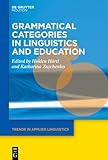Grammatical Categories in Linguistics and Education / ed. by Katharina Zaychenko, Holden Härtl.
Material type: TextSeries: Trends in Applied Linguistics [TAL] ; 37Publisher: Berlin ; Boston : De Gruyter Mouton, [2024]Copyright date: 2025Description: 1 online resource (VI, 300 p.)Content type:
TextSeries: Trends in Applied Linguistics [TAL] ; 37Publisher: Berlin ; Boston : De Gruyter Mouton, [2024]Copyright date: 2025Description: 1 online resource (VI, 300 p.)Content type: - 9783111139654
- 9783111141060
- 9783111140803
- 420
- online - DeGruyter
- Issued also in print.
| Item type | Current library | Call number | URL | Status | Notes | Barcode | |
|---|---|---|---|---|---|---|---|
 eBook
eBook
|
Biblioteca "Angelicum" Pont. Univ. S.Tommaso d'Aquino Nuvola online | online - DeGruyter (Browse shelf(Opens below)) | Online access | Not for loan (Accesso limitato) | Accesso per gli utenti autorizzati / Access for authorized users | (dgr)9783111140803 |
Frontmatter -- Contents -- Introduction -- Section 1: Theorizing linguistic concepts -- (Reflexively) marked and unmarked anticausatives in grammars of German: A model for foreign/second language learners -- A Programme for L1 Norwegian grammar teaching on generative grounds -- Discourse grammar, discourse coherence, and discourse relations: Evidence from editing-based tasks for teaching English -- Section 2: Connecting linguistic research and language pedagogy -- “Translating” insights of theoretical linguistics into educational settings – with a special focus on resources for Hungarian as L1 -- On the use of (second) language acquisition research for grammar education – a language-acquisition-sensitive approach -- Section 3: The role of empirical data -- What can a corpus do for foreign language teaching? An activity proposal for Chinese learners of Portuguese -- Learning the perfective/imperfective aspectual alternation in L2 Italian through a Cognitive Grammar-inspired pedagogy: A quasi-experimental study -- Setting the base for an “acquisitionally informed pedagogy”: The case of the French verbal system -- Section 4: Implementing linguistic categories into the foreign language learning classroom -- Visualizing English and Swabian tense semantics in the classroom -- Taking cognizance of variation and CLI effects in foreign language learning: The case of the English present perfect -- Teaching and learning the comparative in German: The role of semantic notions -- Conclusion -- Index
restricted access online access with authorization star
http://purl.org/coar/access_right/c_16ec
This volume explores how grammatical categories, as defined by theoretical linguistics, are effectively implemented in language education. Aiming to bridge the gap between linguistic research and language pedagogy, it offers a detailed inquiry that spans theoretical frameworks and empirical data. By presenting a series of insightful studies, this work illustrates how findings from theoretical linguistics can be applied to enhance practical language instruction, demonstrating the reciprocal enrichment of both fields. Essential for linguists, language educators, and researchers interested in the intersections of grammar, cognition, and pedagogy, the volume is organized into four engaging sections. Each section illuminates the nuances of grammar teaching and language acquisition. It begins with a theoretical analysis of linguistic categories across diverse languages, progresses through the links between linguistic research and teaching methodologies, and delves into the role of empirical data in classroom applications. The final section focuses on the practical implementation of linguistic categories in language teaching, promoting a deeper understanding of grammar as a dynamic component of language learning.
Issued also in print.
Mode of access: Internet via World Wide Web.
In English.
Description based on online resource; title from PDF title page (publisher's Web site, viewed 20. Nov 2024)


